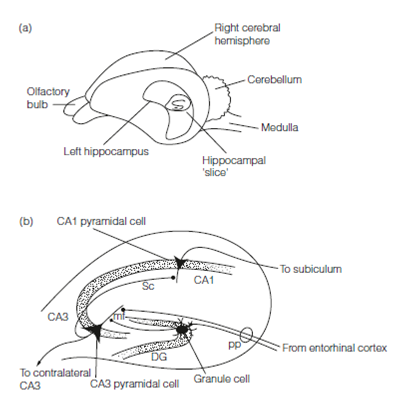Hippocampal circuitry
The hippocampal formation is folded archaecortex (ancient cortex) consisting of the dentate gyrus and the CA (cornu ammonis) collectively termed the hippocampus plus the subiculum. The cortex of the dentate gyrus and cornu ammonis has three layers, although the subiculum is transitional cortex between the hippocampus proper and the six-layered neocortex of the entorhinal area. A main input to the hippocampus from the entorhinal cortex comes through the perforant pathway axons of that synapse with granule cells of the dentate gyrus or pyramidal cells in the CA3 region of the cornu ammonis in Figure. Axons of the granule cells (mossy fibers) also synapse with CA3 pyramidal cells.
The CA3 pyramidal cell axons branch creating:
- Commissural fibers that exceed to the opposite hippocampus
- Efferents that leave the hippocampus through the fornix to terminate largely in the thalamus or hypothalamus
- Collaterals that turn back to form synapses on the similar and neighboring CA3 cells (recurrent collaterals), or that synapse with cells in the CA1 region of the CA (Schaffer collaterals)
CA1 cell axons go to the subiculum and entorhinal cortex. The perforant pathway, granule cells and pyramidal cells are excitatory and glutamatergic. The hippocampus also harbors inhibitory interneurons which are GABAergic.

Figure: Hippocampus. (a) Location of the left hippocampus in rat brain; a hippocampal slice is at right angles to the long axis of the hippocampus. (b) Structure of a hippocampal slice showing the principal excitatory neurons. From Revest P & Longstaff A (1998) Molecular Neuroscience. BIOS Scientific Publishers. DG, dentate gyrus; pp, perforant pathway; Sc, Schaffer collateral; mf, mossy fibers.
These help generate intrinsic oscillations (theta and gamma rhythms) which are essential for memory and learning. Other inputs to the hippocampus involve a cholinergic pathway from the septum (needs for theta rhythm) and serotinergic axons and modulatory noradrenergic from the brainstem reticular system.
Theoretical modeling of the hippocampal circuitry suggests how it might work. The dentate gyrus may act to keep sensory representations coming from the entorhinal cortex segregated. Intriguingly, recent evidence suggests that this requires new neurons to be born (neurogenesis) in spatial learning. The recurrent connections of CA3 allow associations between entorhinal inputs (i.e., episodic memories) to be rapidly established and then incorporated into neocortical long-term memory (i.e., consolidation) over a period of a few weeks. CA1 acts as a novelty detector by comparing stored memories with ongoing sensory information. Encoding in CA1 corresponds to input from entorhinal cortex while retrieval from CA1 corresponds to CA3 input. At each of the synapses in the hippocampus spike timing-dependent plasticity is seen; long-term potentiation in the hippocampus has been extensively researched.